week6 Blog | Course Reflection and CAP‘s Exhibition Practice Learning
![{"data":{"playId":"","stickerId":"","pictureId":"CEC99D8C-BCD6-4726-88C5-BA141F7EE043","enter_from":"enter_launch","imageEffectId":"1012192","product":"retouch","effect_id":"edit","capability_extra_v2":{"imageeffect":[{"resource_id":"6916783724277273101","effect_id":"1012192","origin":"heycan"}],"filter":[{"effect_id":"87689656","resource_id":"7429656172535222835","origin":"heycan"}]},"capability_key":["edit","imageeffect","filter"],"activityName":"","filterId":"7429656172535222835","infoStickerId":"","appversion":"12.0.0","os":"ios","effect_type":"tool"},"source_type":"douyin_beauty_me"}](https://blogs.ed.ac.uk/s2648436_curating-2024-2025sem2/wp-content/uploads/sites/11134/2025/02/IMG_6677-scaled.jpeg)
⚫️Reflection on Adam Lewis Jacob’s Lecture

Week 6 lecture, by author.
This lecture deepened my understanding of how artist-run spaces navigate the tension between autonomy and sustainability. Among the several art spaces he mentioned:
Transmission remains committed to a publicly funded, non-hierarchical model but must negotiate institutional constraints.
Céline, with its grassroots approach, prioritises artistic experimentation but faces financial .
Meanwhile, The Modern Institute demonstrates how an artist-run space can evolve into a commercial gallery, securing long-term viability at the potential cost of its radical ethos.
These case studies highlight the diverse strategies independent spaces employ to sustain themselves while challenging mainstream art structures.
Reflection:
What struck me most was the political nature of curatorial decisions in these spaces. Whether through collective governance, anti-market positioning, or a hybrid model, each space reflects a different mode of resistance to institutional control. This connects to my research on alternative economies in the art world—could a market-fictioning approach offer new ways to sustain independent spaces without compromising their experimental edge? It also raises critical questions about class dynamics and accessibility in these spaces—do they genuinely disrupt exclusionary structures, or do they reproduce their own forms of gatekeeping? These tensions remain central to understanding how independent art spaces function as sites of both resistance and adaptation.
⚫️Reflection on Curation presentation

Week 6 presentation, photo by Beini Cai.
`
In the afternoon workshop this week, we showed the curatorial content and progress we are currently working on. Our group’s presentation is just like our group name, with rich themes and novel content. I also saw from our group that everyone is paying attention to the loss of traditional culture and resources and the right of women to speak.
What impressed me most was Jianglu Xiao’s “River Sounds and Memories”, which allowed exhibitors to integrate and share their private memories to form an interesting collective memory to awaken everyone’s memories of river resources and protect the environment.

Art Example of Yuewen Sun’s presentation, photo by the author.
In addition, I am very interested in Yuewen Sun’s theme of “women’s appearance anxiety” because it is related to my work on “women’s inequality in the family”, but her work is more inclined to the pressure imposed by society on women. The exhibition installation she showed also fits the name of our group “Avant”, and it well demonstrates the use of contemporary art in these themes.


Advice from a tutor,photos by author.
After I presented my curatorial content, according to the feedback from tutor Marcus, we are curating as curators, so we need to pay more attention to the form of curation and the connection and cooperation with artists. Among them, I played the audio I recorded and edited at the end of the presentation, and Marcus thought that we could find relevant sound artists to cooperate. And in the part of electronic music and dance performance about Fiona, he suggested that I could set a scene for the performance, set off the atmosphere, and better convey the theme of marriage as a transaction sound.
⚫️CAP’s Exhibition Practice Learning
On the afternoon of February 27, we went to the Royal Botanic Gardens in Edinburgh to visit and learn about the exhibition practices of contemporary art practice students from the same college. Since the exhibition is located in the botanical garden, without any introduction, I initially thought that each of them connected the concept of their work with plants, which was well integrated into the curatorial site environment.
Photos from the exhibition:
▪️Artwork 1
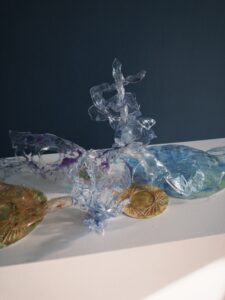
Shaping, by Ruonan Li,2025.
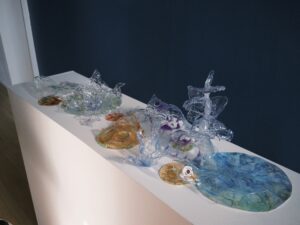
▪️Artwork 2
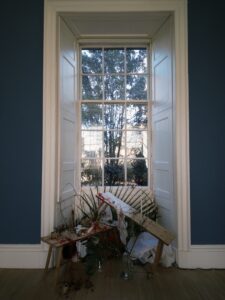
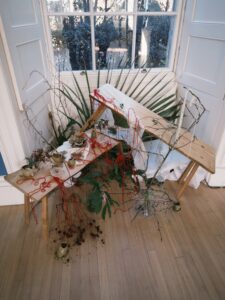
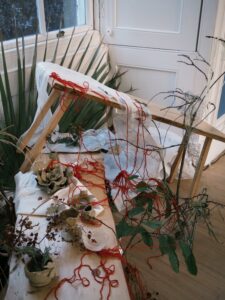
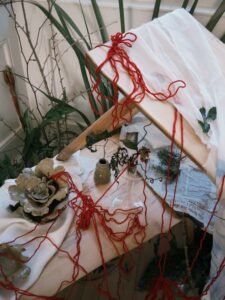
▪️Artwork 3


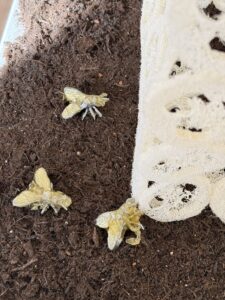

▪️Artwork 4
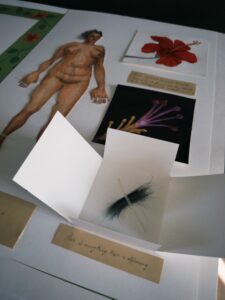
Comparing Specimens, by Sanchari Sinha, 2025.
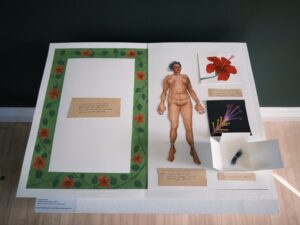
▪️Artwork 5






▪️Artwork 6

Arbor x Hermaphroditum, by Zhuo Rui, 2025.




On the afternoon of February 27, our class visited and learned about the pop-up exhibition themed “Corpse Flower” by students majoring in contemporary art practice in the same college. In the exhibition, students used many artistic methods to display the theme: oil painting, sculpture, multimedia, interactive installation, specimens, etc. Among them, the work “Arbor X Hermaphrodite 2025” (Artwork 6) by Zhuorui Han touched me the most. From her introduction, I learned that she explored the coexistence of nature and humans, which resonated deeply with my thinking about the unequal status of women in the family. The artist blurred the boundaries between gender, biology and social construction by combining the trunks of male and female reproductive organs, grafting techniques, and bird nests woven with human hair. This fusion not only challenges the binary gender concept, but also triggers my reflection on how family structure shapes women’s bodies.

Introduction of “Arbor X Hermaphrodite 2025”, posted by Zhuorui Han
In the family structure, women are often seen as symbols of fertility, nourishment and care. Their bodies are like the earth, endowed with the natural attributes of nourishing life. Just as the bird’s nest in the work symbolizes the continuation of life, women’s bodies are often institutionalized into the cycle of fertility and family labor. But this “naturalization” setting ignores the constraints that the family places on women’s bodies – women are expected to be mothers, wives, and caregivers, and these roles are not biological necessities, but shackles imposed by the social system.
Han asks in the work introduction: “Is gender a gift from nature or a social construct?” This is closely related to the definition of women’s roles in the family system. Women’s presence in the family is often seen as “natural” – they are considered better at raising children and taking care of others than men, but is this really a result of nature or social structure? The work uses the “grafting” of tree trunks to metaphorically represent this forced combination, while also revealing the process of women being “shaped” in the family structure.
In addition, the details of the work – a bird’s nest woven with human hair – reminded me of the emotional labor of women in the family. Hair is a private and personal body element, and using hair to build a nest symbolizes women’s dedication to the family and the invisible constraints that bind them to the family. At the same time, the three quail eggs in the bird’s nest symbolize the fragility of life, echoing the position of women in the family – they are given the mission of nourishing life, but may lose their autonomy due to the family power structure.
Therefore, at the communication meeting on March 13, I plan to have further discussions and connections with Han, hoping to include her works and ideas in the my curation design.
Bibliography
The photos all by author.
The screenshot “Introduction of ‘Arbor X Hermaphrodite 2025′”, posted by Zhuorui Han, Accessed February 27, 2025,
URL: https://www.instagram.com/p/DGoEa1doKJE/?igsh=MzRlODBiNWFlZA==.




Your question about market-fictioning approaches is thought-provoking. It would be interesting to explore how these spaces could build financial sustainability without losing their radical spirit, especially in a world that often values profit over experimentation.
The idea of ‘market-fictioning’ is really intriguing as a potential model for artist-run spaces to sustain themselves without losing their experimental edge. It seems like finding a balance between financial stability and artistic freedom will be key to their future viability.
The idea of market-fictioning to sustain independent spaces is so intriguing. It’s a fine line between keeping a space experimental and ensuring it’s financially viable. I wonder if there’s a model that could allow for more autonomy without sacrificing sustainability.
I find it fascinating how artist-run spaces must constantly negotiate the tension between autonomy and the need for financial sustainability. It raises important questions about how these spaces can remain true to their radical principles without sacrificing their viability.
I found your point about the political nature of curatorial decisions particularly thought-provoking. It makes me wonder how artist-run spaces can navigate financial constraints without compromising their mission. Have you come across any successful hybrid models that balance both?
I completely agree with your thoughts on class dynamics in these spaces. It’s important to ask who gets access to these spaces and who is excluded. Do you think artist-run spaces can truly be inclusive without compromising their autonomy, or is there a fundamental tension there?
Blog:
Your week four to week six blog posts evidence an active practice of reflection, well done—keep going. You have evidently considered key theories (auditory phenomenology, deep listening) and artists who work with relevant themes (Yasmine des Astres), and this testifies to a degree of independent research. Now that you have begun to focus on the experience of women specifically, however, it would be beneficial to further scaffold your approach with an appropriate feminist critique (looking to Audre Lorde, bell hooks, Judith Butler, to name a few). The very recent publication ‘Bodies of Sound: Becoming a Feminist Ear’ might be of interest here.
Curating is not a top-down activity in that you should remain open to allowing artists and artworks to influence the shape and direction of the project, rather than corralling them into a fixed framework of narrative. Try to think of the artists involved more as creative collaborators—consider how you can develop a structure that best supports their ideas, rather than using them to illustrate your argument. If you don’t know where to begin, the artist is a great place to start.
Please try to keep each post to 200–300 words.
Formative presentation:
Your presentation showed that you have developed a strong narrative proposal following a three-chapter life cycle of a woman. This is supported by appropriate reading from theories of sound and feminist critique. You have also considered the venue, environment and potential collaborators with some thought. However, the strength of your vision also risks diminishing the contribution and individual agency of the artists such that it isn’t always clear where the art ends and the curation begins: who would be making the installations out of sanitary towels, for example? Are you fashioning yourself as the artist? Your proposal would benefit here from centring the collaborators on their own terms and considering what curatorial decisions would best support their practices.
Your reference list suggests you have undertaken some productive reading on the topic (Ahmed, LaBelle and Oliveros are promising) and I would encourage you to consider how that might also inform the format of the project as well as the theme. Here, you should look to examples of contemporary exhibition-making to move towards a Speculative Independent Curatorial Project which is routed in an appropriate discursive field and understand how it relates to the work of others sound-based/feminist projects.
Thank you for your detailed feedback! I am glad to hear that my blog has been reflected in retrospective and research independence, and I appreciate your suggestions for improvement.
Regarding the blog part, the lack of feminist theory you mentioned is indeed a direction I need to go deeper into. I will read the book you recommended, Bodies of Sound: Becoming a Feminist Ear, and combine the theories of Audre Lorde and Judith Butler to support my argument with a more accurate critical method. At the same time, I will also reflect on how to make curation more open, rather than just fixing the artists’ works in a given framework. In addition, I will pay attention to the number of words in the blog to ensure that the content is refined and focused.
Regarding last week’s formative presentation, I realized that I need to define the relationship between curator and artist more clearly to avoid blurring the relationship between art creation and curation. For example, the sanitary napkin installation you mentioned did make me reflect – did I inadvertently cross the line and divide the role of curator into the aspect of art creation? This question made me realize that I need to be more proactive in allowing artists and their works to maintain their subjectivity in the exhibition narrative, rather than just using their works to support my curation. Next, I will rethink the meaning of the works of the artists I chose.
In addition, your suggestions made me realize that I should not only apply theory to the theme of the exhibition, but also let theory influence the form of the exhibition. For example, I will study the theories of Ahmed, LaBelle and Oliveros in depth, and think about how to reflect these ideas in the exhibition space, sound experience and interactive methods. At the same time, I will study and analyze other cases of women’s sound art exhibitions to see how they combine curatorial and theoretical practices in practice.
Thank you again for your suggestions, I will implement these improvements in the next revisions and research! If there are further guidance or reference suggestions, I would also like to receive your comments!😊